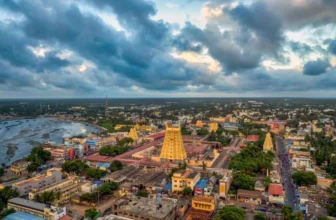The Dasavatharas, or the ten incarnations of Lord Vishnu, are more than mythological tales; they symbolize profound spiritual and philosophical truths. One fascinating perspective views these incarnations as a metaphor for the stages of human development, from birth to self-realization, and even as a reflection of the evolutionary journey of life.
1. Matsya (The Fish)
- Representation: Life begins in water, mirroring the aquatic phase of human development during embryonic stages.
- Human Correlation: Just as Matsya saves the Vedas and mankind, a fetus is nurtured and protected in the amniotic fluid, signifying the foundation of life.
2. Kurma (The Tortoise)
- Representation: Stability and adaptability.
- Human Correlation: As the infant transitions from the womb to the external world, it learns to stabilize itself physically and mentally, much like the Kurma supporting the churning of the ocean.
3. Varaha (The Boar)
- Representation: Emergence from the depths of ignorance or chaos.
- Human Correlation: A child begins to explore the material world, discovering sensory experiences while laying the groundwork for individuality.
4. Narasimha (The Man-Lion)
- Representation: Overcoming primal fears and instincts.
- Human Correlation: In early childhood, as fears and challenges arise, a child starts to recognize courage and protection as essential virtues, much like Narasimha’s role in conquering Hiranyakashipu’s tyranny.
5. Vamana (The Dwarf)
- Representation: Humility and the beginning of intellectual growth.
- Human Correlation: The dwarf symbolizes a growing mind, curious yet unassuming. It’s the phase when children begin to understand their potential and limitations.
6. Parashurama (The Warrior with the Axe)
- Representation: The fiery phase of adolescence and self-assertion.
- Human Correlation: Like Parashurama’s righteous wrath, teenagers often exhibit a rebellious spirit, striving to assert their identity and values.
7. Rama (The Ideal Man)
- Representation: Adulthood and adherence to values.
- Human Correlation: This stage reflects the phase of maturity, where one strives for responsibility, morality, and balance, embodying ideals in personal and professional life.
8. Krishna (The Divine Strategist)
- Representation: Wisdom, love, and playfulness.
- Human Correlation: In this phase, individuals embrace the complexities of life with grace, navigating challenges with intellect, charm, and spiritual growth.
9. Buddha (The Enlightened One)
- Representation: Detachment and spiritual awakening.
- Human Correlation: Later in life, people often seek deeper truths, moving beyond material pursuits to inner peace and enlightenment, much like Buddha’s teachings of liberation from suffering.
10. Kalki (The Future Warrior)
- Representation: The ultimate transformation and renewal.
- Human Correlation: Symbolizing the end of one cycle and the preparation for a new one, this could relate to legacy, transcending the mortal journey, and the soul’s renewal in the eternal cycle of birth and rebirth.
Conclusion
The Dasavatharas serve as a reminder that every phase of life has its own purpose and lessons. They inspire us to navigate the journey of human birth, growth, and evolution with resilience, wisdom, and faith, aligning ourselves with the cosmic rhythm of existence.
What are your thoughts on this perspective? Let us know in the comments!











